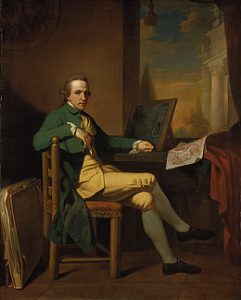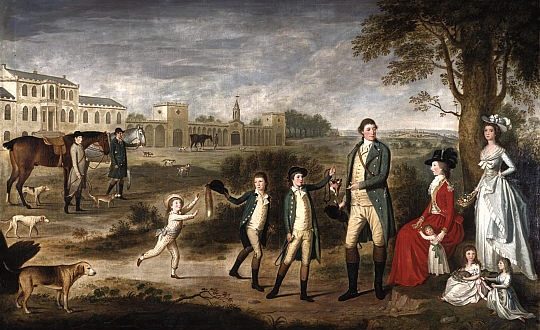In this guest post, Dr Nel Whiting takes a look at the role of gender in shaping the portraiture of David Allan (1744-96), specifically in his family portrait of the Erskines of Torrie.
Follow Nel on Twitter at @nel_whiting
Historical portraits are more than likenesses of people from the past; they are artful constructions, imbued with multifaceted meaning. As such they can tell us much about the attitudes and customs of their time and place. This blog will draw on this quality to explore aspects of elite Scottish family life in the 1780s.
Portraiture and patronage in the eighteenth century
In the 18th century portraits were not ‘private’ but existed in the public domain; displayed in the houses of the sitters and their families, which operated as places of business and entertainment, as well as being visited by genteel tourists. Portraits were also shown in artists’ studios and galleries. The genre constituted the largest percentage of works submitted to Royal Academy exhibitions between 1781 and 1785; anyone with the inclination, and who could afford the shilling entry fee (in 1771 there were 22, 485 such attendees), could come and gawp. Portraits, of society beauties, military heroes, politicians and others who had achieved fame or notoriety, were also distributed as prints and used to decorate houses across the class spectrum.

A Royal Society exhibition, by Thomas Rowlandson and Augustus Charles Pugin.
Portrait painting was a competitive business and patronage was a prerequisite to artistic survival. It enabled the Scottish artist David Allan (1744-96) to study in Glasgow and Italy. Returning from Italy he settled in London but was unable to make a living, so returned to ‘my frds in Scotld & found imployment’. While the patronage of his ‘friends’ (a circle of intermarried landowning families) sustained him, it also meant that whatever his artistic aspirations, he was forced to produce the paintings his sponsors required. Hence, despite wishing to be a history painter, he was forced to earn a living primarily through portrait commissions. As he bemoaned, the ‘genius of our artists is unhappily forced to accommodate itself to the general taste for Portrait’.
One such portrait commission is the Erskine of Torrie family portrait executed in the 1780s, reproduced at the top of this post.
A gendered reading
The painting is divided into two parts along gender lines; the five female members of the family are squashed into a third of the canvas space, where the males occupy the rest. The controlled and constrained movements of the females in that tight pictorial space contrast with the expansive gestures of the males in the broad pictorial space. Indeed, the whole picture reverberates with gender messages about the ‘appropriate’ behaviour for both sexes. Typical of such views, the philosopher Jean-Jacques Rousseau stated that ‘men and women are unlike… man should be strong and active; the woman should be weak and passive’. It is as if his words have been made visual here and it is important to recognise portraits as espousing a society’s values as much as any written source.
The eldest girl, Frances, looks out of the picture at us, as if conscious of being observed and comporting herself genteelly to create the correct impression. Certainly, she is old enough to have been trained as an object of male desire, to know that in Rousseau’s words ‘woman is specially made for man’s delight’. She is fashionably and decoratively dressed: her large picture hat with feathers and bows, her pale blue dress with ruffles hardly seem appropriate for the outdoor setting. The tininess of her waist is emphasised by the sash that encircles it and by her stance, with her left hand on her hips. The youngest girl, Magdalene, cuddles into her mother while her slightly older sisters, Henrietta and Elizabeth, care for a rabbit, one nursing it while then other feeds it. They are learning what the Scottish writer James Fordyce described as the ‘honourable station’ of motherhood. He argued that motherhood was ‘a sphere of activity which you all hope to fill, and for which you ought to qualify yourselves as much as possible’. At about five and three, Henrietta and Elizabeth are certainly beginning their qualification early. Portraiture both promoted and reflected this notion and it was a pictorial commonplace to portray girls nursing siblings, dolls or animals; play in life and art imitating expected adult roles.
Meanwhile, the masculine part of the picture is all striding action. Sir William gestures to his heir, also William, who holds out a fox’s head to his mother and sisters. The second son, James, shows the fox’s tail to his little brother, John. This insinuates the boys’ bravery in undertaking such sport and asserts their elite status (the cost of maintaining horses and dogs and the land ownership necessary for hunting putting it out of reach of the common populous). They are, the picture implies, masterful – learning the self-control and authority their sex and class will require of them as they move into manhood. Despite the fact John must have stayed with the females as he is not dressed for the hunt, as his father and brothers are, he nonetheless takes his place in the male part of the picture. He is further aligned with masculinity as he is running energetically and eagerly, arms outstretched towards the spoils of the hunt with a freedom a movement not seen amongst his sisters. Despite his tender years, his masculinity is evidenced by his actions.

Robert Allan, self-portrait
Many family group portraits of this period contain not just immediate or extended family but servants and retainers, in this instance the grooms. They are not equal to their masters, but pictorial props which underscore the elite status of the Erskine men whom they serve. This is emphasised as their sex ensures their inclusion in the male part of the picture, but their class excludes them from the circle formed by the Erskines.
Concluding remarks
Making a virtue out of a patronage-led necessity was a pragmatic skill for an artist; it could be the difference between comfort and starvation. Until he secured a steady income (as Drawing Master at the Trustees’ Academy), David Allan (left, in a self-portrait) accommodated himself ‘to the general taste for Portrait’ and left behind a body of work which illuminates many of the gendered expectations of life at that time.
Further reading
Dr Nel Whiting gained her PhD from the University of Dundee in 2019. Her research focuses on portraiture and the gendered nature of the family in 18th-century Scotland.


Comments are closed.